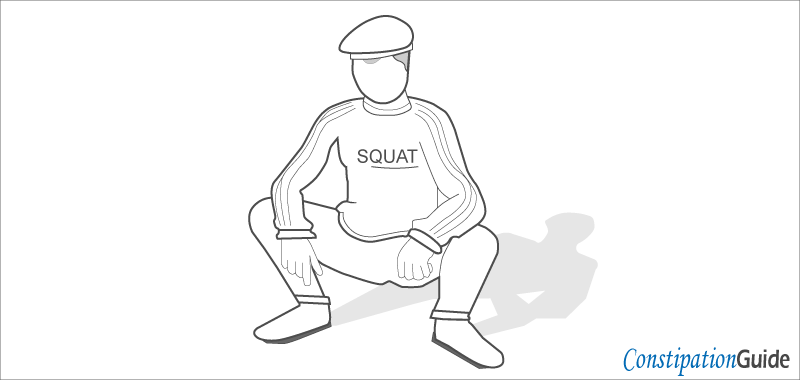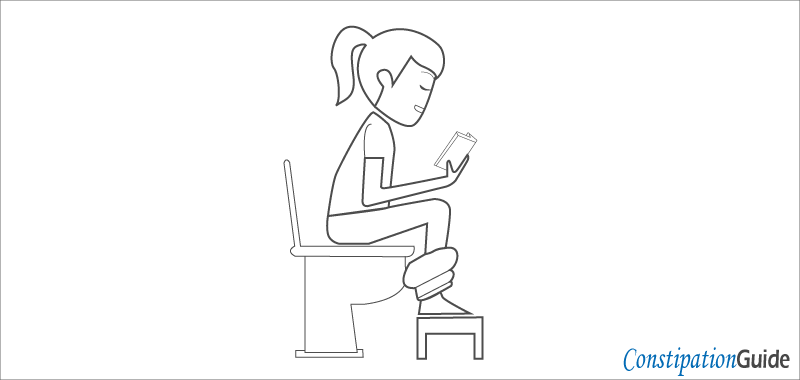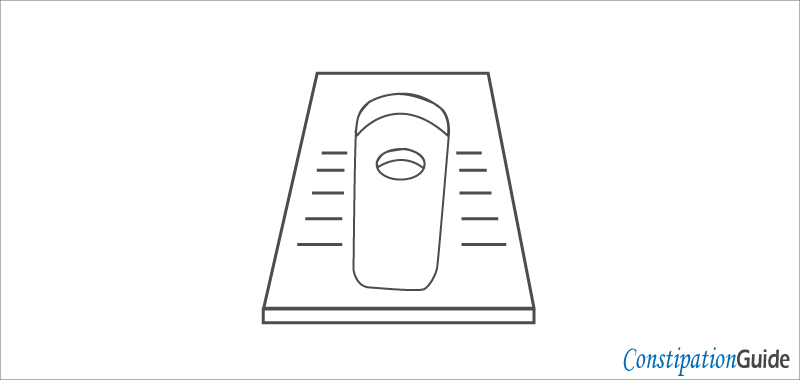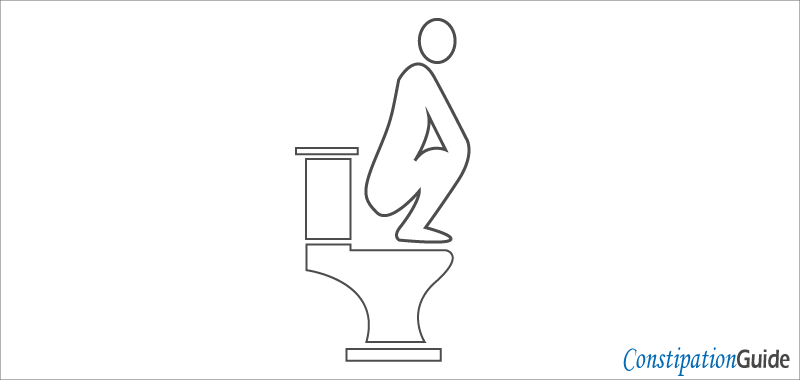BEST POSITION TO POOP IN WHEN CONSTIPATED - 3 WAYS TO USE IT
- Medically reviewed by: Horia Marculescu, MD
- Photo credits: Licenses / Author
- Last updated: 19.02.2024

The squat position is the best position to poop in when constipated because:
- It relaxes the puborectalis muscle.
- It increases the anorectal angle to unlock the kink at the entrance to the rectum.
- It creates pressure and a clear path for the stool to evacuate.
- After defecation, the anorectal angle will naturally decrease to its initial state to prevent incontinence.
The squat position facilitates smooth defecation and prevents constipation. Also, you will know when it’s time to poop and how to prepare your body.
Follow the rest of the guide to learn more about the benefits of the squat position.
1. SQUAT BEFORE STOOL EVACUATION

The squat position is the best position to poop in when constipated because it relaxes your entire bottom and helps bowel movement.
The squat position increases the anorectal angle and relaxes the puborectalis muscles.
Prepare your body first whenever you go to the toilet and think about constipation relief.
How to position yourself?
- Place yourself in the middle of the room, on your feet.
- Move your feet sideways until you have some space between them.
- Now lower your body down slowly until your belly reaches your knees.
- Stay in this position for 5-10 seconds and return to the initial posture.
What you want to achieve is to relax the puborectalis muscles and prepare for defecation.
If you squat 15-20 minutes before you decide to poop, you will feel the stool moving inside the large intestine.
Sometimes you will feel the stool ready for evacuation, but the rectum and anus are still under tension. When you have this feeling, it is essential to squat even more.
“In many countries, people use the squatting posture as the primary posture for bowel evacuation.”
This position facilitates stool evacuation with ease by increasing hip flexion and obtuse rectal angle.
“It is a clever way to do partial squats while waiting for your toast. Or to do hamstring stretches during TV commercials.”
You can also do partial squats by holding onto a stable object like a countertop.
2. THE SEMI-SQUAT POSITION

After preparation, sit on the toilet bowl using the Semi-Squat position.
It can also be considered the best position to poop in when constipated because it does the same thing as the full squat position.
The difference is that you position yourself on the toilet bowl using a low-rise footstool.
The only way to do this thing is to have a low-rise footstool under your feet. Any similar type is excellent.
How to position yourself?
- Place your footstool in front of the toilet bowl.
- Turn your back towards the footstool.
- Place your feet on the footstool.
- Drop your pants.
- Place your bottom on the toilet seat.
Stay in this position 5-10 minutes before you poop.
If it takes longer than 10 minutes to have results, your rectum and anus are not relaxed enough.
When you feel it is time to poop, stay in the Semi-Squat position on the toilet bowl.
You will feel when the fecal matter is moving downwards in the descending colon.
When this thing happens, slowly strain the rectum. Do not push too hard and too often. Push your rectum gently and repeat.
The semi-squat position facilitates a helpful way to sit on the toilet bowl because it makes defecation smoother.
Also, it prevents you from straining too much.
View this step as a way to have constipation relief before you go to the toilet.
When you feel your bottom stiff or stuck up after 15-20 minutes, then move away.
According to a medical study about constipation and squat-assist devices to aid elderly patients:
“The squat position is a practical solution to avoid constipation. People use squatting as a traditional and natural posture for defecation all around the world.”
“Several devices or objects can assist the posture (footstool), especially if there are people who have temporary or permanent muscle issues.”
3. USE THE SQUAT POSITION IN AN INDIAN TOILET

Turkish and Indian toilets are excellent places to have stool evacuation because:
- You squat all the time.
- You relax the anorectal muscles.
These things are ideal for toilet positions and constipation relief because it requires less effort. And it makes defecation feel natural.
That is why the squat position is the best position to poop in when constipated.
Indian and Turkish toilets do not have a toilet bowl or a seat. These types usually have two feet soles, which raise a bit from the ground and an evacuation hole on the floor.
The toilet is like a container that keeps your feet up and lets the water flush between them.
An Indian toilet is always better than the modern toilet bowl, which you can buy from your local store.
According to a medical study about hemorrhoids and squat posture:
“The incidence of hemorrhoids is very low in developing countries. Countries where people squat for bowel evacuation.”
“The modern Western world uses the typical toilet posture for bowel evacuation.”
“More traditional countries in Asia, Africa, and the Middle East use the squatting posture.”
“Some people have problems coordinating the pelvic floor muscles when having a bowel movement.”
“For most people, motility is normal but, sometimes they have other difficulties with stool evacuation.”
4. BENEFITS OF THE SQUAT POSITION

The squat position is beneficial in the long term when you deal with constipation.
Besides the benefits mentioned at the beginning of the guide, there are others like:
- It is easy to use.
- It does not require a lot of effort.
- It improves digestion in the long term.
- It has no side effects compared to taking medicine.
- It empties the intestines by relaxing the anorectal canal.
You can squat with ease on the toilet bowl with a footstool and have the same result.
To empty your intestines quickly, you can also take bile or pancreatic supplements. And combine them with 10 minutes of squatting.
You would be surprised how easy it is to defecate without suffering from side effects and taking too much medicine.
According to a medical study about squatting and knee motion:
“Squatting is a core exercise. Anyone can use this posture with suitable foot placement angles.”
5. ANY WORKING POSITIONS?

Although the following examples are not the best positions to poop in when constipated, they help move the stool with little effort.
I. THE PUSH-UP POSITION:
Position yourself with your back on the floor and stay there as if you were practicing push-ups.
When you position yourself, try the following:
- Raise your knees halfway to the hips.
- Try to move your head towards the knees.
- Stay in this position, but don’t do the push-up.
- Stay in this position for 1-5 minutes.
What you want to achieve is to relax the puborectalis muscles and to create enough pressure inside the abdomen.
II. KNEES ON THE GROUND POSITION:
Sitting on your knees is one of the best positions because it’s similar to squatting.
Also, it brings your knees near the abdomen and creates pressure inside the intestines.
How to use it:
- Position yourself with your knees on the floor.
- Place the shin on the ground.
- Move your body forward and backward.
Also, place your hands in front of you and move your palms on the ground. Use your arms to lower and raise your body.
III. LEAN FORWARD POSITION:
Another position that can help you is leaning forward once you’re on the toilet bowl.
Leaning your body forward (with your hand parallel to the ground) creates pressure inside the abdomen.
Practice this technique as follows:
- Position yourself comfortably on the toilet bowl.
- Lean forward slowly.
- Stay in that position for 30 seconds.
- Come back and take 30 seconds of pause.
- Repeat these steps five times (left or right).
If nothing happens after ten times then, the anorectal canal is not ready for stool evacuation.
6. WHAT ELSE HELPS STOOL EVACUATION?

I. WALK TEN MINUTES.
Although it is not related to the best position to poop in when constipated, walking helps you move the stool.
Walking helps you, especially if you sit in a chair longer than usual.
Any muscle movement that involves the abdomen and feet can be a relief for constipation in the short term.
II. DRINK FRESH FRUIT JUICE.
Fruit juice helps to relieve constipation even before going to the toilet and choosing the posture.
Fruits bring the necessary amounts of vitamins and nutrients required to hydrate the body. Also, fruit juice creates fermentation in the intestines.
Fermentation creates gas inside the intestines. And gas forces the stool to move towards the rectum, especially if you contract and compress the abdominal muscles.
III. LYING ON THE SIDE:
- Before you decide to poop, lay on the bed for 1-5 minutes on your left side.
- After that, place yourself on the right side for another 5 minutes.
- Be careful not to fall asleep.
This position is excellent because it forces the abdominal muscles to contract and expand.
You can bring your knees close to the abdomen if you feel the stool moving.
IV. LYING ON YOUR TUMMY.
Lying on your abdomen compresses the intestines and creates pressure with gas and stool.
This position is similar to the one mentioned above and has excellent results.
- Place yourself on the bed with your abdomen towards the mattress.
- Stay 1-5 minutes.
- Get up and take a break.
- Lay down on the bed for another 5 minutes.
Lying on the bed for 10 minutes should be enough to make the stool move.
When you feel it is time to poop, go to the toilet, and repeat the first steps in this guide.
“Body position and stool characteristics and each influence stool evacuation in the long term. Lying on the side acts as a light massage on your tummy. It is like a small stimulus before defecation.”
7. KEEP IN MIND
Squatting is the best position to poop in when constipated because
- It increases the anorectal angle.
- It relaxes the puborectalis muscles.
- It clears the anorectal canal.
You can squat with ease. And you can combine it with other techniques like walking or drinking fresh fruit juice.
If you suffer from severe constipation for more than three months, then it is time to see a doctor.
Take blood and stool tests to help you and the doctor establish a diagnosis and treatment.
The advice and the techniques in this guide cannot replace the opinion and the diagnosis of an authorized and specialized doctor.
According to a medical guide about digestion and constipation:
“Avoid sitting on the toilet bowl for long periods. Also, try to avoid straining the rectum.”
Last medically reviewed on 19.02.2024
TRUSTED MEDICAL SOURCES
1. Primary constipation: An underlying mechanism (B.A.Sikirov)
2. Update on the Management of Constipation, Arnold Wald, MD1
3. Jose-Remes-Troche/ The-use-of-pictograms-to-identify-postures-associated-with-constipation.pdf
